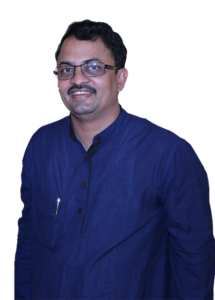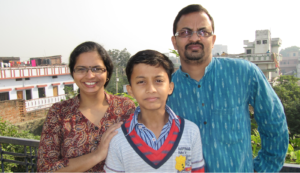Born on 18 May 1970 at Varanasi
Mother’s name: Shrimati Savitri Devi
Father’s name: Surendra Nath Singh
Married to Shruti Nagvanshi on 22 February 1992;
Child: A son, Kabeer Karunik
Contact: SA 4/2 A, Daualtpur, Varanasi-221002, India
Email: lenin@pvchr.asia Mobile: +91-9935599333
Lenin Raghuvanshi is the symbol of resistance to millions of lower caste people known as Dalits fighting for their dignity in India. Lenin is credited with changing the discourse on Dalit Politics in India and bringing into focus an innovative “people centric” approach to reclaim “human dignity” for the deprived sections in a caste ridden Indian society. The gamut of Lenin’s activities reflects his personal and ideological span and provides credibility and a sense of completeness to the work he does. His care for details, meticulous planning, diligent patience, and sincere advocacy on the issues concerning the marginalized, has made millions of his supporters optimistic about a dignified future.
Lenin’s vision on caste, conflict and social change took a concrete shape while working with the bonded labourers in India. He was born into a high caste Hindu family which he describes as “feudal.” He noticed that not a single child bonded in the sari or carpet industries came from an upper caste, even though some high-caste families were often just as poor as the lower castes. He realized that caste, not class, was at work. By the end of 1996, Lenin was championing for a major cause that is to fight for the basic rights of lower-caste people. Early experiences taught him that confrontation was essentially dangerous and not the most effective emancipatory tool. Increasingly, Lenin recognized the role of caste in all kinds of social conflicts and therefore envisioned a movement that could break the closed, feudal hierarchies of conservative slums and villages by building up local institutions and supporting them with a high profile and active human rights network.
As a self-taught Dalit ideologue, Lenin understood from the beginning that village in India is the cradle of oppression and exploitation. Instead of tampering with the symptoms, ‘caste’ needed to be tackled by both its horns. On the one hand he created a democratized structure for the ‘voiceless’ to enable them access to the constitutional guarantees of modern India and on the other, his innovative advocacy forced the ‘state’ to sensitize its mechanisms to deliver social justice in a manner where Justice is not only done but perceived to be done.
Lenin conceived of a folk school which not only enabled empowerment of the poor, but also endowed them with the ability to access information and justice through the constitutional mechanism of the state. To translate policy into practice, Lenin has begun working on the latest part of his strategy, Jan Mitra Gaon, or the People-Friendly Village. These villages have durable local institutions that work to promote basic human rights in the face of continuous discrimination. Lenin has adopted three villages and one slum as pilot projects, which include reactivating defunct primary schools, eradicating bonded labor, ensuring girl child education, and promoting non-formal education. The village committees comprise of at least 50 percent Dalits, and seek to realize greater political representation of Dalits in village councils. The heads of the village committee and village council, a government representative, and a PVCHR employee serve as a conflict resolution group and form the People-Friendly Committee. The approach of the organization is two-fold: to have a strong grassroot organization to work for democratic rights of those in marginalized communities and second, to create the structure and dynamics to receive the assistance of national and international institutions.
 Lenin’s work marks a shift in the Indian human rights movement, which has been reluctant to address injustices in the name of caste as a fundamental human rights issue. He is one of only a handful of activists to declare that such discrimination goes against democratic principles by promoting inequality. While working from Varanasi in Uttar Pradesh–one of the most traditional, conservative, and segregated regions in India–Lenin never fails to demonstrate his resolve.
Lenin’s work marks a shift in the Indian human rights movement, which has been reluctant to address injustices in the name of caste as a fundamental human rights issue. He is one of only a handful of activists to declare that such discrimination goes against democratic principles by promoting inequality. While working from Varanasi in Uttar Pradesh–one of the most traditional, conservative, and segregated regions in India–Lenin never fails to demonstrate his resolve.
With less economic resources, but rich with confidence and conviction, Lenin in a short period of time has managed to amplify the voice of the marginalized in national and international fora through “Peoples SAARC”, rehabilitation and resettlement of weavers of Varanasi; Benaras Convention; Election Watch; prevention of torture; voice against hunger and many such activities. Recognition by the international community of Dr Lenin’s work is indeed the recognition for the millions whose hopes and aspirations rest on his slender shoulders.
Lenin Raghuvanshi was born in a higher caste Hindu family, to Surendra Nath Singh and Shrimati Savitri Devi, on 18 May 1970. His grandfather Shanti Kumar Singh, was a Gandhian freedom fighter. He did his bachelor’s course in Ayurveda, Modern Medicine and Surgery from the State Ayurvedic Medical College, Gurukul Kangari, Haridwar in 1994. Lenin married Shruti Nagvanshi on 22 February 1992 and has a son, Kabeer Karunik.
From the beginning, Raghuvanshi was averse to the caste system. He refers to his higher caste Hindu upbringing as “feudal”. This sprung the seed of social activism in him. He became the president of the Uttar Pradesh chapter of United Nations Youth Organisation at the age of 23 (1993).
With his exposure into the mainstream society, he realised that casteism is present in all walks of life. With the Indian Government tackling the issue with its reservation policies and making it perennial, Raghuvanshi chose the path of uplifting them by making their voices heard. He founded the People’s Vigilance Committee on Human Rights (PVCHR) in 1996, along with his wife, Shruti Nagvanshi, historian Mahendra Pratap, musician Vikash Maharaj, and poet Gyanedra Pati.